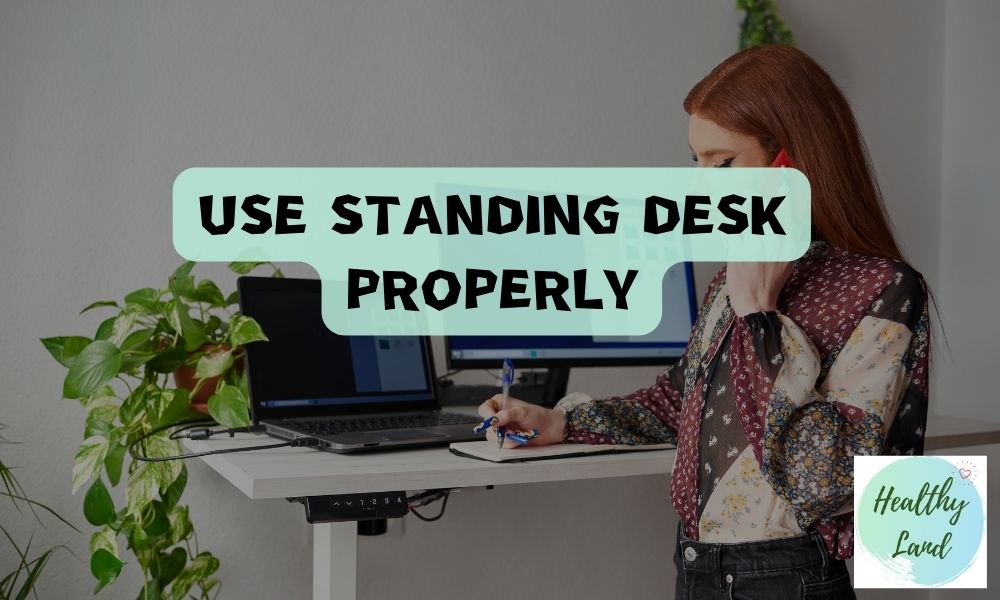- How to Use Your Standing Desk Correctly - February 4, 2024
- Why the Need for Standing Desks for Children & Teens - February 4, 2024
- 3 Types of Standing Desks Suitable for Home Use - February 4, 2024
To use a standing desk correctly, you should first check and be aware of both your standing and sitting positions. Next, depending on whether you are using a desktop monitor screen or a laptop, you should adjust the screen accordingly so that you are using the standing desk ergonomically which benefits you.
Standing Position with a Standing Desk
There are 3 main things to remember when you are in a standing position while using the standing desk. They are elbow alignment, posture and wrist position, which will be discussed further (and also displayed in the image below).

1. Check Your Elbow Alignment
Proper elbow alignment while using a standing desk is important because it helps keep your shoulders relaxed and in a neutral position. When your elbows are bent at a 90-degree angle, your shoulders are naturally relaxed and your muscles are not working as hard to support your arms. This can help to prevent shoulder pain and tension.
2. Check Your Posture
First, adjust the height of your desk so that your elbows are bent at a 90-degree angle when you are typing or using the mouse. This will help to keep your shoulders relaxed and your spine in a neutral position.
Next, keep your feet flat on the floor or on a footrest to distribute your weight evenly and prevent back pain. Avoid leaning forward or backward so as not to strain your neck and back.
3. Check Your Wrist Position
Keep your wrists straight. When your wrists are bent, it puts pressure on the tendons and nerves in your forearm, which can lead to carpal tunnel syndrome and other repetitive strain injuries. Keeping your elbows bent at a 90-degree angle will in turn keep your wrists straight and reduce the risk of injury.
Sitting Position with a Standing Desk
Like standing position, there are also 3 things to check on while you are sitting at a standing desk. They are sitting posture, elbow alignment and chair height (as displayed in the following image and further elaborated in the section below).

1. Check Your Sitting Posture
Your head and neck should be in a neutral position, with your chin parallel to the floor. Avoid tilting your head forward or backward for extended periods of time.
Your wrists should be straight and supported while typing or using the mouse. You can use a wrist rest or a padded keyboard tray to help support your wrists.
2. Check Elbow Alignment
Your elbows should be bent at a 90-degree angle to keep your shoulders relaxed and reduce strain on your neck and upper back. Keep your forearms parallel to the ground to keep your wrists in a neutral position and prevent carpal tunnel syndrome.
Also, the keyboard should be level with your elbows or slightly lower to keep your wrists straight and avoid putting pressure on them.
3. Adjust the Height of the Chair
The seat should be at a height that allows your feet to rest flat on the floor or a footrest. The chair should be supportive and adjustable, with a backrest that curves to support your lower and upper back.
How to Position Monitor on a Standing Desk
There is a difference in how you position your monitor on a standing desk depending on what type of computer you use. As shown in the diagram below, you will need to adjust accordingly whether you are using a laptop or a computer monitor screen. Monitor positioning is important to prevent eye strain and neck pain. Read on to learn how to position specific monitors correctly.

If You Use a Laptop on a Standing Desk
- Elevate the laptop screen to eye level. This will help to prevent neck pain and eye strain. You can use a laptop stand, stack of books, or other stable surface to raise the screen.
- Position the laptop screen so that the top third of the screen is in line with your eyes when you are sitting up straight. This will help to keep your head and neck in a neutral position.
- Keep the laptop screen at least 50 cm (19 inches) away from your face. This will help to prevent eyestrain.
If You Use a Monitor Screen on a Standing Desk
The top of the monitor should be at or slightly below eye level. This will help to prevent neck strain. You can use an adjustable monitor stand or riser to achieve the correct height.
The monitor should be placed at least 50 cm (19 inches) away from your eyes. This will help to reduce eye strain and fatigue.
How to Make Standing Desk More Comfortable?
To make your standing desk more comfortable, you can enhance your standing desk experience by taking standing breaks so your legs can get some rest. You can also do simple stretches to reduce fatigued muscles from sitting or standing too long.
Taking a break from standing can help improve circulation and prevent fatigue. Varying your stance or taking a mini walk every 20 to 30 minutes would be beneficial. Doing simple stretches like neck, shoulder, back or calf stretches can help make your working day with a standing desk more comfortable.
Don’t skip the image below so you will be reminded of these tips.

How Long to Stand When Using a Standing Desk?
The recommended standing duration for a standing desk depends on a number of factors, including your individual health, fitness level, and work environment.
However, a good rule of thumb is to stand for about 1 hour for every 1-2 hours of sitting. This means that if you work an 8-hour day, you should aim to stand for at least 4 hours.
How High Should a Standing Desk Be?
The ideal standing desk height depends on your height and the type of work you do. However, a good rule of thumb is to set the desk so that your elbows are at a 90-degree angle when you are typing. This means that the desk should be about elbow height.

